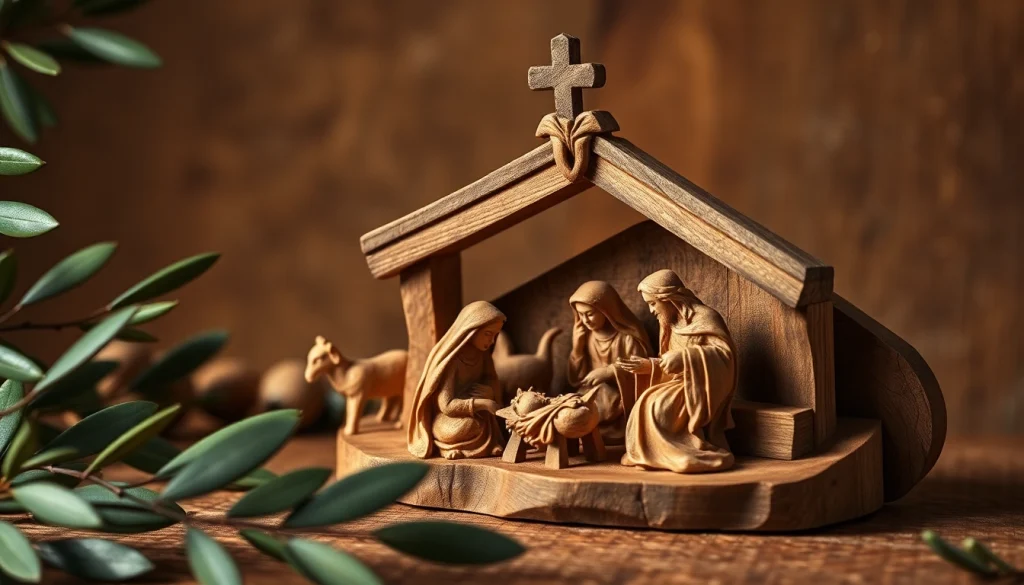Exquisite Olive Wood Carvings: A Journey Through Artisan Craftsmanship

Understanding Olive Wood Carvings
Olive wood carvings are not merely decorative items; they encapsulate centuries of tradition, craftsmanship, and spirituality. Originating from the ancient olive trees that grow in the Mediterranean region, particularly in areas like Bethlehem and Jerusalem, these artisanal pieces carry with them a profound cultural significance. To explore their beauty is to embark on a journey into a legacy of artistry and faith. Whether you are interested in hand-carved figures or intricate religious symbols, olive wood carvings offer a tangible connection to history and spirituality.
The History and Significance of Olive Wood
The tradition of olive wood carving in the Holy Land can be traced back to ancient times. Olive trees are central to the Mediterranean landscape, symbolizing peace and prosperity. According to historical texts, these trees have been cultivated for thousands of years, with their wood revered for its durability and striking grain. The craft of carving has been passed down through generations, often within the same family, fostering a rich heritage among the local Christian artisans.
In religious contexts, olive wood is particularly significant; for instance, it is often used to create nativity scenes depicting the birth of Christ. The symbolism attached to the olive branch as a peace offering also reinforces the theological dimensions of the art form. By purchasing olive wood carvings, individuals not only acquire a piece of art but also support the preservation of this cultural craft, ensuring that future generations can continue to pass down these valuable traditions.
How Olive Wood Carvings are Made
The crafting of olive wood carvings entails a meticulous process that begins with sustainably sourcing wood from pruned trees. Artisans carefully select pieces, aiming to highlight the wood’s natural patterns and hues—characteristics that make each piece unique. The carving process typically involves several stages, including sketching, shaping, and finishing. Each artisan may have their specific methods, often employing techniques that they have mastered over many years.
The tools used in olive wood carving can range from traditional hand tools to more modern machinery. However, many artisans prefer the traditional route, believing that it not only preserves the integrity of the wood but also enhances the character of the finished piece. The finishing touches often involve sanding and applying oils, which enrich the color and enhance the natural grain of the wood.
Types of Olive Wood Carvings Available
When it comes to olive wood carvings, the diversity is astounding. From religious figures like crosses and nativity sets to decorative items such as bowls, utensils, and figurines, there is something for everyone:
- Religious Symbols: Crosses, statues of saints, and nativity scenes are incredibly popular, particularly among those seeking heirloom-quality spiritual art pieces.
- Home Decor: Carvings like bowls, serving trays, and wooden boxes not only serve practical purposes but also bring an element of beauty into the home.
- Figurines: These can range from small, intricate animal figures to life-sized sculptures, embodying various themes from everyday life to spiritual representation.
The Art of Carving: Techniques and Tools
Traditional Tools Used in Olive Wood Carving
The tools employed in olive wood carving are integral to the craft, with some artisans utilizing tools that have been unchanged for generations. Traditional chisels, knives, and gouges allow for precise detailing and shaping. Wood carving machines may also be used for larger pieces, but much of the intricate work remains hand-done. Some tools can be highly specialized, tailored to the unique grain and density of olive wood.
Hand-Carving vs. Machine Carving
While advancements in technology have made machine carving a feasible option for mass production, hand-carving remains the preferred method for many artisans who value the personal touch and artistry involved in their work. Hand-carved pieces are often more valuable due to their unique details and craftsmanship. Each imperfection and mark tells a story and highlights the human element behind the creation.
Maintaining Quality in Craftsmanship
For artisans, maintaining quality is paramount. This involves not only refinement of technique over years but also a commitment to using sustainably sourced wood, as well as a passion for the art that translates into the final product. Many artisans keep their workshops humble, focusing on the quality of work rather than quantity. This philosophy ensures that every piece of art produced meets high standards.
Selecting the Perfect Olive Wood Carving
Factors to Consider When Buying Olive Wood Carvings
When choosing olive wood carvings, several factors come into play:
- Authenticity: Ensure you are purchasing from reputable artisans or stores to guarantee that the wood is genuine and sustainably sourced.
- Craftsmanship: Look closely at the detailing of the piece. High-quality carvings will have smooth finishes and intricate details that showcase the skill of the artisan.
- Purpose: Consider whether the piece is a gift, a decorative item, or religious art. Each context may influence the style and type of carving you choose.
Popular Items and Their Symbolism
Many olive wood carvings carry deep symbolism. For instance:
- Crosses: Representing faith, crosses made from olive wood often serve as reminders of spirituality in daily life.
- Nativities: These pieces frequently symbolize hope and new beginnings, perfect for holiday decor and spiritual reflection.
- Figurines: These can represent various aspects of life, faith, and culture, often gifting stories through their intricate designs.
Customization Options for Olive Wood Art
Customized olive wood carvings are increasingly popular, allowing individuals to select specific designs, sizes, or even inscriptions that hold personal significance. Artisans often can create bespoke pieces tailored to individual requests, making for a unique present or keepsake. This personal touch not only enhances the intrinsic value of the carving but also creates a deeper emotional connection to the piece.
Caring for Your Olive Wood Carvings
Cleaning and Maintenance Tips for Longevity
Preserving the beauty and integrity of olive wood carvings requires consistent care:
- Cleaning: Use a damp cloth to wipe the surface, avoiding submerging in water. A mild soap can be used for stubborn stains, but ensure it’s rinsed off thoroughly.
- Oiling: Periodically, applying food-grade mineral oil or beeswax can help restore luster and nourish the wood.
Storing Your Olive Wood Pieces Properly
Proper storage is essential to prevent damage. Keep olive wood carvings away from direct sunlight or excessive humidity, which can lead to warping or cracking. Ideally, store them in a climate-controlled environment and consider using felt pouches or soft fabric to protect them from scratches.
Repairing Minor Damages and Scratches
While olive wood is durable, minor scratches can be repaired easily. For superficial scratches, rubbing in mineral oil can often conceal imperfections. For deeper scratches, using fine sandpaper followed by oiling can help restore the wood’s surface. In cases of significant damage, consultation with a professional conservator may be necessary.
The Cultural Impact of Olive Wood Carvings
Olive Wood Carvings in Religious Contexts
Olive wood carvings are deeply woven into the fabric of religious life. They serve as decorative elements in homes and places of worship, often encapsulating the essence of faith and devotion. Figures depicting Biblical stories or saints frequently feature in Christian traditions, providing congregants with a visual representation of their beliefs and spirituality. These carvings contribute significantly to the ambiance and heritage of religious celebrations, particularly during Christmas and Easter.
Supporting Local Artisans and Communities
By purchasing olive wood carvings, consumers are not merely acquiring decorative items; they are supporting local artisans and their communities. The craft of carving is vital to the livelihoods of many families in Bethlehem and Jerusalem. Choosing authentic pieces helps to foster economic sustainability and cultural preservation. This conscious consumerism creates a ripple effect, allowing cultural traditions to thrive in an ever-globalizing world.
The Future of Olive Wood Craftsmanship
As the world becomes increasingly interconnected, the future of olive wood craftsmanship hangs in the balance. While globalization may pose challenges to traditional methods, it also presents opportunities for outreach and education. Artisans are beginning to use social media and online marketplaces to share their skills and artistry with a broader audience. This helps to ensure that the craftsmanship of olive wood carving retains its relevance and continues to inspire future generations.
Overall, the journey through the world of olive wood carvings is filled with rich history, cultural significance, and exceptional artistry. Each carving is not just an object, but a narrative of traditions, values, and the unyielding spirit of artisans devoted to their craft.







